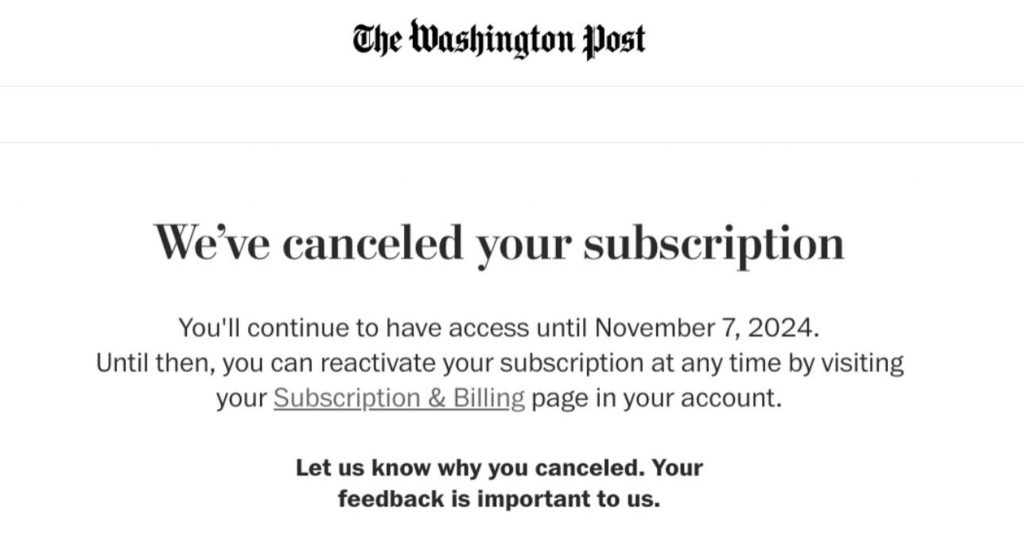Over recent months, the Washington Post has seen a notable drop in subscriptions, and the reasons are varied but interconnected. With changing reader preferences, frustration over customer service, and rising subscription costs, many are reconsidering where they get their news. Here’s a look into why this trend is happening and what it says about the evolving landscape of journalism.
Content Concerns and Reader Discontent
A significant factor behind the cancellation wave is subscriber dissatisfaction with the quality and tone of the Post’s content. Readers have expressed frustration over an increase in opinion-driven pieces, arguing that the news has shifted too far toward sensationalism and away from hard-hitting, objective journalism. While the Washington Post remains a leader in investigative reporting, some long-time subscribers feel that its offerings have become a mix of opinion-heavy articles that stray from the unbiased reporting they expect. This aligns with a broader trend across media, where readers are increasingly fatigued by polarized political coverage and are turning to more neutral or niche publications for what they perceive as a more grounded perspective.

Moreover, there’s been a growing interest in alternative media sources like Substack, where individual writers and journalists offer tailored content on specific topics, often at a fraction of the cost. This trend is particularly appealing to those seeking concise, specialized news without wading through content they find repetitive or overly partisan. For many, subscribing to specific journalists rather than entire news organizations offers a better balance of depth, engagement, and affordability.
Rising Subscription Costs and Value Concerns
With print and digital ad revenues dropping industry-wide, publications like the Washington Post have increasingly turned to subscriptions to generate revenue. However, price hikes have left some subscribers questioning whether they’re getting enough value for their money, especially when other platforms offer competitive and often less expensive alternatives. According to Nieman Lab, readers are more likely to unsubscribe if they feel the cost no longer aligns with the quality of content, especially with so much free or lower-cost information available online.
This trend reflects a broader “subscription fatigue” where readers are overwhelmed by the sheer number of paid services now competing for their attention, including streaming, news, and specialty content platforms. In today’s market, news outlets must balance profitability with value, offering content that is both distinct and worth the price to avoid subscriber loss.
Frustration with Customer Service and Cancellation Processes
Customer service issues and cumbersome cancellation processes also play a significant role in driving cancellations. While the Washington Post offers an online cancellation option for digital subscriptions, its print subscribers must still call to cancel, which can be time-consuming and frustrating. In fact, many readers have reported challenges navigating the cancellation process, with complaints about long wait times or having to repeatedly contact customer service to fully complete a cancellation.

For publications, these frustrations can backfire, potentially deterring any future return by customers who might have reconsidered subscribing later on. The Washington Post’s Chief Subscriptions Officer has commented on the importance of a seamless experience, noting that creating a frictionless process builds goodwill and can even facilitate “win-backs” if subscribers feel respected and not pressured to stay.
For many customers, especially those accustomed to the ease of canceling services like Netflix or Spotify, struggling to cancel a news subscription can feel outdated and unnecessary.
The Bigger Picture: Changing Media Preferences
The decline in Washington Post subscriptions also mirrors broader changes in media consumption. Many readers are diversifying where they get their information, with a renewed interest in local journalism, nonprofit news outlets, and specialized digital platforms that feel more relevant to their day-to-day lives. Additionally, there’s an increased desire for news that isn’t limited to a traditional newspaper’s style, format, or editorial perspective.
As the landscape of journalism continues to evolve, news outlets like the Washington Post may need to adapt their approach to content, pricing, and customer engagement to maintain a loyal subscriber base. This might mean reevaluating their editorial mix, providing a more seamless cancellation experience, and potentially exploring alternative revenue models to sustain high-quality journalism without leaning so heavily on subscription price increases.
In the end, the surge in cancellations signals a call for media organizations to innovate and meet the changing needs of their readers. Whether through more flexible subscription models, diverse content offerings, or simplified user experiences, retaining readership may require taking a closer look at what today’s readers really value in their news subscriptions.














